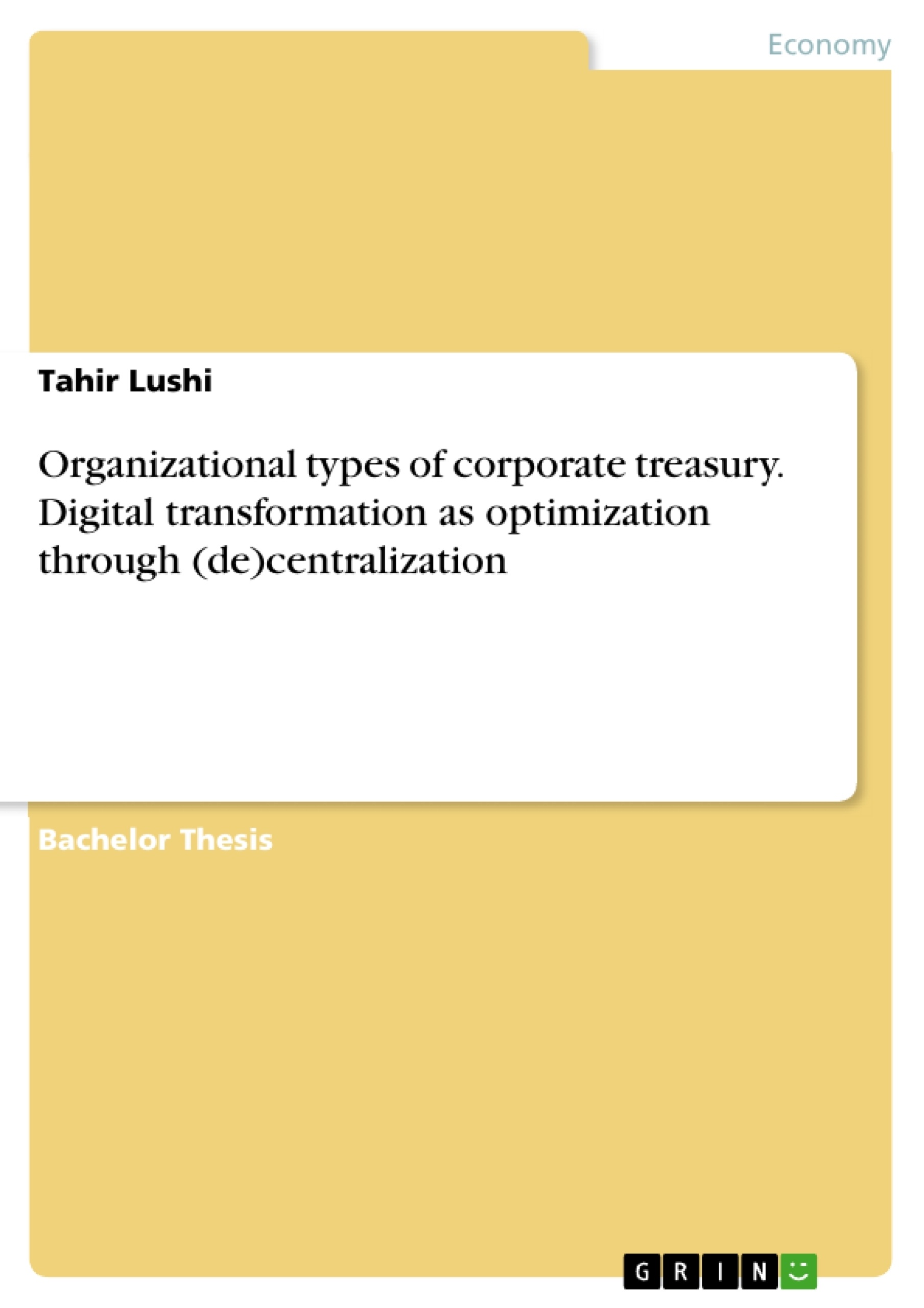
Organizational types of corporate treasury. Digital transformation as optimization through (de)centralization
Bachelorarbeit, 2020
53 Seiten, Note: 1,0
Leseprobe
Table of Contents
- Introduction
- Corporate treasury function and its management
- Organizational types of corporate treasury
- Fully decentralized corporate treasury
- From decentralized towards the centralized treasury
- Regional treasury centres
- Fully centralized corporate treasury
- Important regulatory aspects for the corporate treasury
- Criteria catalogue for an optimal corporate treasury
- Decentralized vs. centralized organization of corporate treasury
- Cash and liquidity management
- Governance and risk management
- Bank relationships management
- In-house banks as an enabler of centralized corporate treasury
- Future vision - digital corporate treasury
- Digital corporate treasury – a technology ecosystem
- Transformation path towards digital corporate treasury
Objectives and Key Themes
This thesis analyzes the organizational structures of corporate treasury functions within the context of digital transformation and new regulations. The primary objective is to determine the optimal level of centralization for corporate treasury operations that maximizes the benefits of emerging technologies such as AI, data analytics, and blockchain. The research compares different organizational models, including fully decentralized, hybrid, regional, and fully centralized structures.
- Optimal Centralization of Corporate Treasury
- Impact of Digital Transformation on Treasury Operations
- Analysis of Different Treasury Organizational Models
- Role of New Technologies in Corporate Treasury
- Importance of Governance and Risk Management in Treasury
Chapter Summaries
Introduction: This introductory chapter sets the stage for the thesis by highlighting the impact of new technologies on organizational structures, specifically within the context of corporate treasury. It contrasts the trend towards decentralization in other sectors with the ongoing push for centralization in corporate treasury. The chapter establishes the central research question: what is the optimal level of centralization for corporate treasury to fully utilize the potential of new technologies? It outlines the thesis's structure and methodology, previewing the analysis of different organizational types of corporate treasury, regulatory aspects, and the development of a criteria catalogue for optimal treasury performance. The chapter concludes with a roadmap of the subsequent chapters, including the comparative analysis of centralized and decentralized models, the exploration of in-house banks, and a forward-looking perspective on digital corporate treasury.
Corporate treasury function and its management: This chapter provides a foundational understanding of the corporate treasury function and its management. It delves into various organizational structures for corporate treasury, including fully decentralized, partially centralized (moving toward centralized), regional treasury centers, and fully centralized models. Each model is thoroughly explained, illustrating their advantages and disadvantages. The chapter also examines relevant regulatory aspects influencing corporate treasury operations. Finally, it introduces a criteria catalogue designed to assess the effectiveness of different treasury organizational structures, considering factors that contribute to optimal performance. This catalogue serves as a crucial framework for the comparative analysis in subsequent chapters.
Decentralized vs. centralized organization of corporate treasury: This core chapter forms the analytical heart of the thesis. It systematically compares decentralized and centralized approaches to key treasury processes: cash and liquidity management, governance and risk management, and bank relationships management. For each process, it analyzes the strengths and weaknesses of both organizational models, using the criteria catalogue established in the previous chapter as a benchmark. The chapter meticulously examines how the chosen organizational structure influences the efficiency and effectiveness of these core treasury functions. A significant portion is dedicated to exploring in-house banks as a potential enabler for increased centralization, analyzing their implementation and impact on overall treasury operations. This chapter provides a detailed, comparative analysis to inform the later discussion of optimal treasury structure.
Future vision - digital corporate treasury: This chapter offers a forward-looking perspective, exploring the potential of digital technologies to transform corporate treasury functions. It discusses the concept of a "digital corporate treasury" as a technology ecosystem, outlining the various technologies involved, such as AI, robotic process automation, data analytics, and blockchain, and their potential applications within treasury operations. The chapter explores the transformation path toward a digital corporate treasury, identifying key steps and challenges involved in such a transition. It provides insights into how organizations can successfully navigate the digital transformation of their treasury functions, ensuring an effective and future-proof operation. The chapter likely offers strategic recommendations for organizations aiming to leverage technology for improved efficiency and effectiveness.
Keywords
Corporate treasury, centralization, decentralization, digital transformation, technology ecosystem, AI, data analytics, robotic process automation, blockchain, cash and liquidity management, governance, risk management, bank relationships management, in-house bank, regulatory aspects, optimal treasury structure, performance optimization.
Frequently Asked Questions: A Comprehensive Guide to Corporate Treasury Organization
What is the main topic of this thesis?
This thesis analyzes the optimal organizational structure for corporate treasury functions, considering the impact of digital transformation and new regulations. It focuses on determining the ideal level of centralization (fully decentralized, hybrid, regional, or fully centralized) to maximize the benefits of emerging technologies like AI, data analytics, and blockchain.
What are the key themes explored in this work?
Key themes include the optimal centralization of corporate treasury, the influence of digital transformation on treasury operations, a comparative analysis of different treasury organizational models, the role of new technologies in corporate treasury, and the importance of governance and risk management within the treasury function.
What organizational structures of corporate treasury are discussed?
The thesis explores various corporate treasury organizational structures: fully decentralized, partially centralized (transitioning towards centralization), regional treasury centers, and fully centralized models. Each model's advantages and disadvantages are examined in detail.
How does the thesis compare decentralized and centralized treasury structures?
A core chapter provides a systematic comparison of decentralized and centralized approaches to key treasury processes: cash and liquidity management, governance and risk management, and bank relationships management. It analyzes the strengths and weaknesses of each model for each process, using a developed criteria catalogue as a benchmark.
What is the role of an in-house bank in corporate treasury?
The thesis examines the role of in-house banks as a potential enabler for increased centralization in corporate treasury. It analyzes their implementation and impact on overall treasury operations, considering their influence on efficiency and effectiveness.
What is the "digital corporate treasury" concept, and how is it discussed?
The thesis presents a future-oriented perspective on "digital corporate treasury" as a technology ecosystem utilizing AI, robotic process automation, data analytics, and blockchain. It explores the transformation path towards this digital model, identifying key steps and challenges.
What is the criteria catalogue, and how is it used?
A criteria catalogue is developed to assess the effectiveness of different treasury organizational structures. This catalogue, considering factors contributing to optimal performance, serves as a crucial framework for the comparative analysis of centralized and decentralized models.
What regulatory aspects are considered in this thesis?
The thesis examines relevant regulatory aspects that significantly influence corporate treasury operations and the choices of organizational structures.
What are the key takeaways or conclusions of the thesis?
The thesis ultimately aims to determine the optimal level of centralization for corporate treasury to fully leverage the potential of new technologies while considering regulatory requirements and operational efficiency. The detailed comparative analysis and criteria catalogue provide a robust foundation for making informed decisions about treasury organization.
What are the key words associated with this research?
Key words include: Corporate treasury, centralization, decentralization, digital transformation, technology ecosystem, AI, data analytics, robotic process automation, blockchain, cash and liquidity management, governance, risk management, bank relationships management, in-house bank, regulatory aspects, optimal treasury structure, performance optimization.
Details
- Titel
- Organizational types of corporate treasury. Digital transformation as optimization through (de)centralization
- Hochschule
- Fachhochschule Bielefeld
- Note
- 1,0
- Autor
- Tahir Lushi (Autor:in)
- Erscheinungsjahr
- 2020
- Seiten
- 53
- Katalognummer
- V935823
- ISBN (eBook)
- 9783346265838
- ISBN (Buch)
- 9783346265845
- Sprache
- Englisch
- Schlagworte
- Corporate Treasury Finance Management digitalisation Banks governance centralisation
- Produktsicherheit
- GRIN Publishing GmbH
- Preis (Ebook)
- US$ 20,99
- Preis (Book)
- US$ 30,99
- Arbeit zitieren
- Tahir Lushi (Autor:in), 2020, Organizational types of corporate treasury. Digital transformation as optimization through (de)centralization, München, Page::Imprint:: GRINVerlagOHG, https://www.diplomarbeiten24.de/document/935823
- Autor werden
- Ihre Optionen
- Vertriebskanäle
- Premium Services
- Autorenprofil
- Textarten und Formate
- Services für Verlage, Hochschulen, Unternehmen

- © GRIN Publishing GmbH.
- Alle Inhalte urheberrechtlich geschützt. Kopieren und verbreiten untersagt.
- info@grin.com
- AGB
- Open Publishing
Der GRIN Verlag hat sich seit 1998 auf die Veröffentlichung akademischer eBooks und Bücher spezialisiert. Der GRIN Verlag steht damit als erstes Unternehmen für User Generated Quality Content. Die Verlagsseiten GRIN.com, Hausarbeiten.de und Diplomarbeiten24 bieten für Hochschullehrer, Absolventen und Studenten die ideale Plattform, wissenschaftliche Texte wie Hausarbeiten, Referate, Bachelorarbeiten, Masterarbeiten, Diplomarbeiten, Dissertationen und wissenschaftliche Aufsätze einem breiten Publikum zu präsentieren.
Kostenfreie Veröffentlichung: Hausarbeit, Bachelorarbeit, Diplomarbeit, Dissertation, Masterarbeit, Interpretation oder Referat jetzt veröffentlichen!
- GRIN Verlag GmbH
-
- Nymphenburger Str. 86
- 80636
- Munich, Deutschland
- +49 89-550559-0
- +49 89-550559-10
- info@grin.com
-









